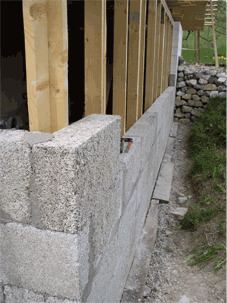 | ||
Hempcrete or Hemplime is bio-composite material, a mixture of hemp hurds (shives) and lime (possibly including natural hydraulic lime, sand, pozzolans) used as a material for construction and insulation. It is marketed under names like Hempcrete, Canobiote, Canosmose, and Isochanvre. Hempcrete is easier to work with than traditional lime mixes and acts as an insulator and moisture regulator. It lacks the brittleness of concrete and consequently does not need expansion joints. The result is a lightweight insulating material ideal for most climates as it combines insulation and thermal mass.
Like other plant products, hemp absorbs CO2 from the atmosphere as it grows. Furthermore the carbonation of the lime during curing adds to this effect as lime turns to limestone.
The typical compressive strength is around 1 MPa, around 1/20 that of residential grade concrete. It is a low density material and resistant to crack under movement thus making it highly suitable for use in earthquake-prone areas. Hempcrete walls must be used together with a frame of another material that supports the vertical load in building construction, as hempcrete's density is 15% that of traditional concrete.
Like other plant products, the hemp crop absorbs carbon dioxide gas as it grows, retaining the carbon and releasing the oxygen. 165 kg of carbon can be theoretically absorbed and locked up by 1 m3 of hempcrete wall during manufacture.
Limecrete, Ltd. (UK) reports a fire resistance rating of 1 hour per British/EU standards.
